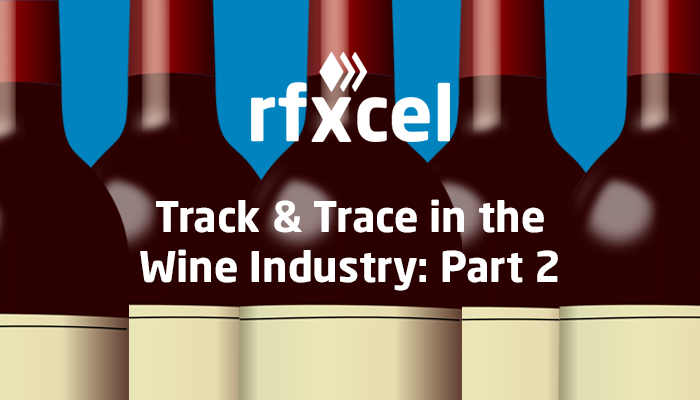Welcome to Part 2 of our wine industry track and trace miniseries. In Part 1, we talked about how track and trace technology can help protect the wine supply chain by building product provenance, fighting counterfeits and illicit trade, streamlining logistics, and building consumer confidence and trust.
Part 2 gets into the details of the wine supply chain — its key actors and their responsibilities for wine industry track and trace. There’s a lot to cover, so let’s get started.
The wine supply chain, defined
The wine supply chain has the same core stakeholders as other supply chains: producers, distributors, and retailers. In its 2009 Wine Supply Chain Traceability Guideline, GS1 says these can be characterized as large companies with “significant technology requirements”; small- to medium-sized enterprises, many with niche specialty products and branding; and “support companies that provide materials, transportation, storage, and other services that are also impacted by traceability.”
GS1 further divides the supply chain into seven stakeholders: grape growers, wine producers, bulk distributors, transit cellars, fillers/packers, distributors, and retail stores. We describe these below, including their roles in wine industry track and trace.
Supply chain actors and their roles in wine industry track and trace
Ingredients and final products can change hands many, many times, so all actors must keep meticulous records and follow GS1 labeling standards to ensure wine industry track and trace. The requirements do get complicated, but there are a few fundamentals to keep in mind:
- Global Location Numbers (GLNs)
- Global Trade Item Numbers (GTINs)
- Serial Shipping Container Codes (SSCCs)
- Application Identifiers (AIs)
- GS1-128 barcodes
- Human-readable codes
- Universal Product Codes (UPCs) and European Article Numbers (EANs)
Grapegrowers
Grapegrowers are responsible for the production, harvest, and delivery of grapes. Wine industry track and trace begins with them, so they must keep detailed records about receiving, shipping, and the vineyard itself. The latter includes the type of vines, annual production record, origin and chemical content of water used for cleaning and irrigation, and treatments (e.g., fertilizers, pesticides, fungicides).
Key data for track and trace describes the “plot” or “block” where grapes are grown. This land is identified with a GLN allocated by the grower and should include five pieces of information:
- The vineyard’s name and address
- The identifier for the plot
- Size of the plot/number of vines
- Vine variety
- Contact details
Every shipment of grapes the growers send should have a GLN and the date of harvest so the receiving winery can have this provenance for the wine it makes.
Wine producers
Wine producers receive the grapes and produce, manufacture, and/or blend wine products. Key wine industry track and trace data follows the grapes as they’re transformed into wine, so producers must keep accurate records of the procedures they use to make every wine. This includes:
- The grape growers’ GLNs
- The wine producer’s own GLN
- The location(s) at the winery where grapes or juice are processed, including de-stemming, crushing, chilling, and pressing
- A GTIN for each product
- An SSCC for shipping containers (e.g., tanker trucks)
- An AI (315n) to indicate the quantity dispatched in liters
- An AI (10) to indicate the batch number
Bulk distributors
Bulk distributors receive wine in bulk from wine producers and send it to transit cellars. They also store, dispatch, process, sample, and analyze bulk wine. The wine they receive has been identified with a GTIN and a batch number; like their downstream and upstream trading partners, they must keep records about what they receive and dispatch, including recording the SSCCs and AIs associated with bulk wine containers.
Bulk distributors are identified with GLNs. Bulk wine containers, such as storage tanks, may hold only one product, or they may hold mixed products with mixed batch numbers; these have different labeling requirements. Generally, they’re identified with an SSCC allocated by the bulk distributor. When put into barcode form, the SSCC is “represented in a GS1-128 symbol.” The containers may also require a GTIN and AIs for batch and quantity.
Transit cellars
Transit cellars are responsible for the receipt, storage, dispatch, processing, sampling, and analysis of bulk wine, plus keeping records about what they receive and dispatch. They may be part of a filler/packer company at the same site or at another location. They can also be a third-party service provider.
For wine industry track and trace, every container a transit cellar sends must be identified with an SSCC, a GTIN, a batch number, and the quantity of wine in liters. This information is encoded in a GS1-128 barcode and in human readable form. To ensure track and trace in the wine industry, transit cellars must record every SSCC, GTIN, and batch number of every item they ship.
Fillers/Packers
Fillers/Packers receive containers of bulk wine from a bulk distributor or a transit cellar. Their job is to put the wine into smaller containers, such as bottles, bags, kegs, and barrels, then send cases, cartons, pallets, or “other logistics units” to finished goods distributors. For wine industry track and trace, here are how these units should be labeled:
- Cases and cartons sold at retail are identified with a GTIN and a barcode with an EAN/UPC symbol. A lot number encoded in a GS1-128 barcode should also applied as an “add-on.” Cases and cartons that will not be sold at retail are identified with AIs and GTINs encoded in a GS1-128 barcode.
- Pallets are marked with SSCCs. Filler/Packers can also include a GS1-128 barcode with AIs containing other information that maintains the parent-child relationship between the pallet and its contents.
- Point-of-sale units (e.g., bottles, cans, jugs, bags in boxes) are identified with a GTIN and have a barcode with an EAN/UPC symbol for scanning at the time of purchase. In the EU and elsewhere, units must display a lot number assigned during the filling process. This information can be in human readable form.
Fillers/Packers also receive the “dry goods” that come in contact with wine, such as bottles, caps, and corks, and must label them with SSCCs, GTINs, and batch numbers. Fillers/Packers also have to record other information about dry goods, such as the water used to wash filling equipment and any chemicals used for cleaning.
Distributors
Distributors receive, store, and dispatch finished goods to retailers. They are also responsible for inventory management, and may repack or re-label goods at a retailer’s request.
If cases, cartons, and pallets are not broken up before being shipped to a retailer, the identification from the filler/packer (e.g., SSCC, GTIN, EAN/UPC symbols) does not change. If items are repacked, each gets a new SSCC. (The original SSCC must be crossed out or obscured). Distributors must record the SSCC, GTIN, and lot number of the items they ship and link these to the GLN of the recipient.
The “Traceability data and GS1 Standards” for items shipped by distributors are as follows (quoted verbatim):
- SSCC of the inbound pallet and GLN of its supplier
- SSCC of the outbound pallet, either unmodified or newly created
- Links between the SSCC of the newly created pallet and the SSCC of the pallets used in its creation and, if applicable, the GTIN and lot number of each carton shipped to the retailer
- GLN of the retail location to which the pallet is dispatched
Retail stores
Retailers receive wine from the finished goods distributor for retail sale. The wine is usually delivered in cases, cartons, and pallets, and records of their SSCCs and lot numbers must be kept. Individual units sold to the final consumer are identified with a GTIN-13 allocated by the brand owner. UPCs or EANs ensure products are scanned/traced all the way to sale to consumers. If a retailer returns goods to a supplier, it must ensure it doesn’t break the wine industry track and trace links that have been established.
Final thoughts
The wine supply chain is complex. Wine industry track and trace will help protect it, make it more efficient, improve communication among stakeholders, and fulfill consumers’ ever-growing expectations for more information about the products they buy.
rfxcel is ready to help. Our rfxcel Traceability System simplifies wine industry track and trace. From raw materials to finished goods, our solutions ensure you build a data-rich provenance for your products, communicate clearly with all your trading partners, comply with industry and government requirements, and give consumers the information they demand. Contact us today to schedule a demo and see what we can do.





